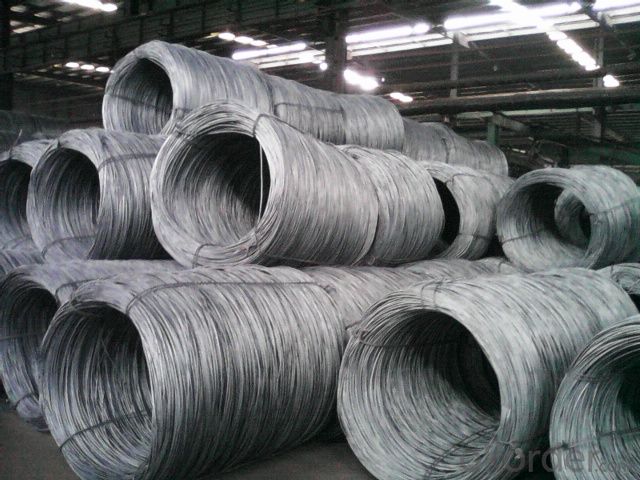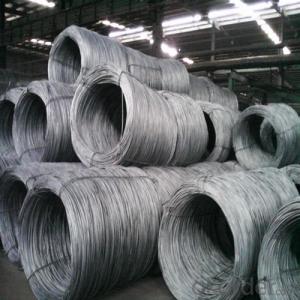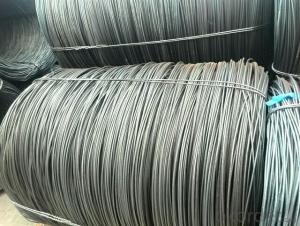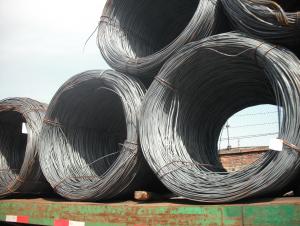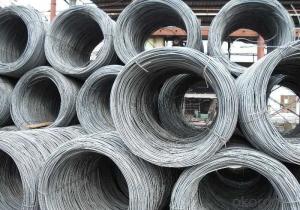Hot rolled wire rod SAE1008
- Loading Port:
- China Main Port
- Payment Terms:
- TT or LC
- Min Order Qty:
- -
- Supply Capability:
- -
OKorder Service Pledge
OKorder Financial Service
You Might Also Like
Product Description:
OKorder is offering Hot rolled wire rod SAE1008 at great prices with worldwide shipping. Our supplier is a world-class manufacturer of steel, with our products utilized the world over. OKorder annually supplies products to European, North American and Asian markets. We provide quotations within 24 hours of receiving an inquiry and guarantee competitive prices.
Steel Grade: Q195/235, SAE1006-1018B Standard: ASTM, GB
Diameter: 5.5mm, 6.5mm, 7mm,8mm,9mm,10mm,12mm,14mm
Type: in coil, coil weight around 2MT Alloy or Not: Alloy
Technique: Hot Rolled Place of Origin: China Mainland
Surface: round, no twisted, light and smooth
Chemical Composition: (Please kindly find our chemistry of our material based on Q195、Q235A and Q235B as below for your information)
Trademark | Rank | Chemical composition (quality score) % | ||||||||
C | Si | Mn | S | P | ||||||
| ≤ |
| ≤ | ≤ | ||||||
Q195 |
| 0.06-0.12 | 0.30 | 0.25 | 0.050 | 0.045 | ||||
Q235 | A | 0.14-0.22 | 0.30 | 0.30-0.65 | 0.050 | 0.045 | ||||
Q235 | B | 0.12-0.20 | 0.30 | 0.30-0.70 | 0.045 | 0.045 | ||||
After hot-rolled the products shaped into coil and delivery as finished product, including round, square, rectangular, hexagonal and so on. Since most of the products are round, it is generally called wire rod. Carbon steel wire rod is widely used in construction and manufacturing. Carbon steel wire rod is mainly used for reinforcement of reinforced concrete and welded structure or reprocessed (roberts , nail, etc.) materials, especially used to produce wire drawing, welding electrode, nails, spring, electronic, precise machinery parts and so on.
Product Applications:
Hot rolled wire rod SAE1008 are ideal for structural applications and are widely used in the construction of buildings and bridges, and the manufacturing, petrochemical, and transportation industries.
Product Advantages:
OKorder's Hot rolled wire rod SAE1008 are durable, strong, and resist corrosion.
Main Product Features:
· Premium quality
· Prompt delivery & seaworthy packing (30 days after receiving deposit)
· Corrosion resistance
· Can be recycled and reused
· Mill test certification
Product Specifications:
Diameter: 5.5mm, 6.5mm, 7mm,8mm,9mm,10mm,12mm,14mm
FAQ:
Q1: What makes stainless steel stainless?
A1: Stainless steel must contain at least 10.5 % chromium. It is this element that reacts with the oxygen in the air to form a complex chrome-oxide surface layer that is invisible but strong enough to prevent further oxygen from "staining" (rusting) the surface. Higher levels of chromium and the addition of other alloying elements such as nickel and molybdenum enhance this surface layer and improve the corrosion resistance of the stainless material.
Q2: How do we guarantee the quality of our products?
A2: We have established an advanced quality management system which conducts strict quality tests at every step, from raw materials to the final product. At the same time, we provide extensive follow-up service assurances as required.
Q3: Can stainless steel rust?
A3: Stainless does not "rust" as you think of regular steel rusting with a red oxide on the surface that flakes off. If you see red rust it is probably due to some iron particles that have contaminated the surface of the stainless steel and it is these iron particles that are rusting. Look at the source of the rusting and see if you can remove it from the surface.
Images:

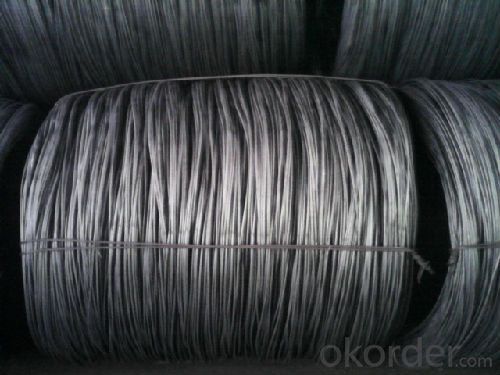
- Q: What are the different cutting methods for steel wire rod?
- There are several different cutting methods for steel wire rods, depending on the specific requirements and desired outcome. Some of the most common cutting methods include: 1. Shearing: This is a simple and widely used cutting method that involves using a pair of shears or a cutting blade to cut the wire rod. Shearing can be done manually or with the help of machinery, depending on the thickness and length of the wire rod. 2. Sawing: Sawing is another commonly used cutting method for steel wire rods. It involves using a saw blade or a band saw to cut through the wire rod. Sawing is typically used for thicker wire rods or when a precise and clean cut is required. 3. Abrasive cutting: Also known as abrasive disc cutting or abrasive wheel cutting, this method involves using an abrasive disc or wheel to grind through the wire rod. Abrasive cutting is often used for cutting thin wire rods or when a smooth and precise cut is required. 4. Flame cutting: Flame cutting, also known as oxy-fuel cutting, is a thermal cutting method that uses a combination of oxygen and a fuel gas (such as acetylene or propane) to create a high-temperature flame. The flame is directed onto the wire rod, melting and cutting through it. Flame cutting is commonly used for thick wire rods or when a fast and efficient cutting method is required. 5. Laser cutting: Laser cutting is a highly precise and efficient cutting method that uses a focused laser beam to melt and vaporize the wire rod. Laser cutting is often used for intricate and complex cutting patterns or when a high level of precision is required. These are just a few of the different cutting methods available for steel wire rods. The choice of cutting method will depend on factors such as the thickness and length of the wire rod, the desired outcome, and the available equipment and resources.
- Q: How is steel wire rod priced in the market?
- Steel wire rod is priced in the market based on various factors that influence its production and demand. These factors include the cost of raw materials, such as iron ore and scrap metal, as well as the cost of energy and labor involved in the manufacturing process. Additionally, market conditions and supply and demand dynamics also play a significant role in determining the price of steel wire rod. Factors such as global economic conditions, trade policies, and infrastructure development projects can impact the demand for steel wire rod, thereby affecting its price. Steel wire rod is often traded on commodity exchanges, where market participants engage in buying and selling contracts based on future delivery dates. The price of steel wire rod on these exchanges is influenced by factors such as market speculation, storage costs, and transportation expenses. Furthermore, the quality and specifications of the steel wire rod also influence its price. Different grades, sizes, and coatings of steel wire rod have varying prices based on their suitability for different applications and industries. Overall, steel wire rod prices are determined by a combination of factors including raw material costs, production expenses, market conditions, supply and demand dynamics, quality specifications, and trading activities on commodity exchanges.
- Q: How is steel wire rod tested for surface finish?
- Steel wire rod is tested for surface finish using various methods such as visual inspection, magnetic particle inspection, and ultrasonic testing. Visual inspection involves visually examining the wire rod for any visible defects or irregularities on the surface. Magnetic particle inspection uses magnetic particles and a magnetic field to detect any surface cracks or discontinuities. Ultrasonic testing utilizes high-frequency sound waves to detect any hidden defects or flaws beneath the surface. These testing methods ensure that the steel wire rod meets the required surface finish standards before it is further processed or used for various applications.
- Q: How is steel wire rod used in the manufacturing of wire mesh gabions?
- Steel wire rod is used in the manufacturing of wire mesh gabions as it serves as the primary material for producing the wire mesh. The steel wire rod is typically shaped into a specific gauge and then woven or welded together to form the mesh structure of the gabions. This provides the necessary strength, durability, and structural integrity required for the gabions to retain their shape and effectively hold back soil or other materials in various construction and landscaping applications.
- Q: What are the different surface protection methods for steel wire rod?
- Some of the different surface protection methods for steel wire rod include galvanization, coating with a protective paint or varnish, and applying a corrosion-resistant coating such as zinc or epoxy.
- Q: How are steel wire rods used in the production of barbed fences for security purposes?
- Steel wire rods are an essential component in the production of barbed fences for security purposes. These wire rods are typically made from high-quality steel, which is known for its strength and durability. To manufacture barbed fences, the steel wire rods are first straightened and then cut into desired lengths. These rods are then fed into a machine that twists them together to form a sturdy wire strand. This twisted wire strand serves as the base for the barbed fence. Once the wire strand is formed, sharp barbs are added at regular intervals along its length. These barbs act as a deterrent, making it difficult for intruders to climb over or pass through the fence. The barbs are typically made by cutting small pieces of the steel wire rod, shaping them into sharp points, and then attaching them securely to the wire strand. The barbed wire strand is then stretched between posts or attached to existing structures to create a formidable security barrier. The high tensile strength of the steel wire rods ensures that the fence remains taut and secure, even under pressure or attempts to cut through it. Barbed fences made with steel wire rods are widely used for security purposes due to their effectiveness in deterring unauthorized access and providing perimeter protection. They are commonly used in prisons, military installations, industrial facilities, and private properties to enhance security and prevent trespassing. In summary, steel wire rods are crucial in the production of barbed fences for security purposes. They provide the strength, durability, and sharpness required to create an effective deterrent against intruders and protect the perimeter of various establishments.
- Q: What are the common raw materials used in steel wire rod production?
- The common raw materials used in steel wire rod production are iron ore, coal, limestone, and scrap metal.
- Q: How is steel wire rod used in the manufacturing of wire for elevator door systems?
- The manufacturing of wire for elevator door systems heavily relies on steel wire rod. For elevator doors to function properly, they need wires that are strong, durable, and capable of enduring constant use and frequent opening and closing. Steel wire rod, derived from steel billets and serving as a semi-finished product, is the primary raw material utilized in wire production. To initiate the process, steel wire rod goes through various mechanical and heat treatments to enhance its strength and flexibility. These treatments, such as hot rolling, drawing, and annealing, refine the wire's structure and enhance its mechanical properties. The objective is to ensure that the resulting wire can withstand the tensions and stresses encountered during elevator door operations. Once the wire rod has undergone processing, it is further drawn and shaped to meet the desired dimensions and specifications for elevator door systems. This involves passing the wire through a series of dies, gradually reducing its diameter and shaping it into the required form. The wire is then cut to the desired length and undergoes additional treatments, such as heat treatment or coating, to further enhance its properties and protect against corrosion. The manufactured wire is subsequently utilized in various components of elevator door systems. It is commonly employed as tension cables or counterweight cables, providing the necessary strength and support for smooth door operation. These wires are meticulously installed, routed, and connected to the elevator mechanism to ensure safe and reliable functionality. In conclusion, steel wire rod is a crucial element in the production of wire for elevator door systems. Through various treatments and processes, it acquires enhanced strength and flexibility, resulting in high-quality wire capable of meeting the demanding requirements of elevator door operations. This wire is then utilized in tension cables and counterweight cables to provide the necessary strength and support for elevator door systems.
- Q: What are the main factors affecting the product consistency of steel wire rod?
- The main factors affecting the product consistency of steel wire rod include the quality of raw materials used, the manufacturing process utilized, the control and monitoring of temperature and pressure during production, and the maintenance and calibration of equipment. Additionally, factors such as the composition of the steel alloy, the presence of impurities, and the level of precision in the wire drawing process can also influence the consistency of the final product.
- Q: What are the main challenges in steel wire rod production?
- Some of the main challenges in steel wire rod production include maintaining consistent quality and specifications, controlling the dimensions and surface finish of the wire rod, ensuring proper heat treatment and metallurgical properties, managing the high energy consumption and environmental impact associated with the production process, and addressing the global competition and market fluctuations in the steel industry. Additionally, ensuring the safety of workers and optimizing production efficiency are also key challenges in this sector.
Send your message to us
Hot rolled wire rod SAE1008
- Loading Port:
- China Main Port
- Payment Terms:
- TT or LC
- Min Order Qty:
- -
- Supply Capability:
- -
OKorder Service Pledge
OKorder Financial Service
Similar products
Hot products
Hot Searches
Related keywords






